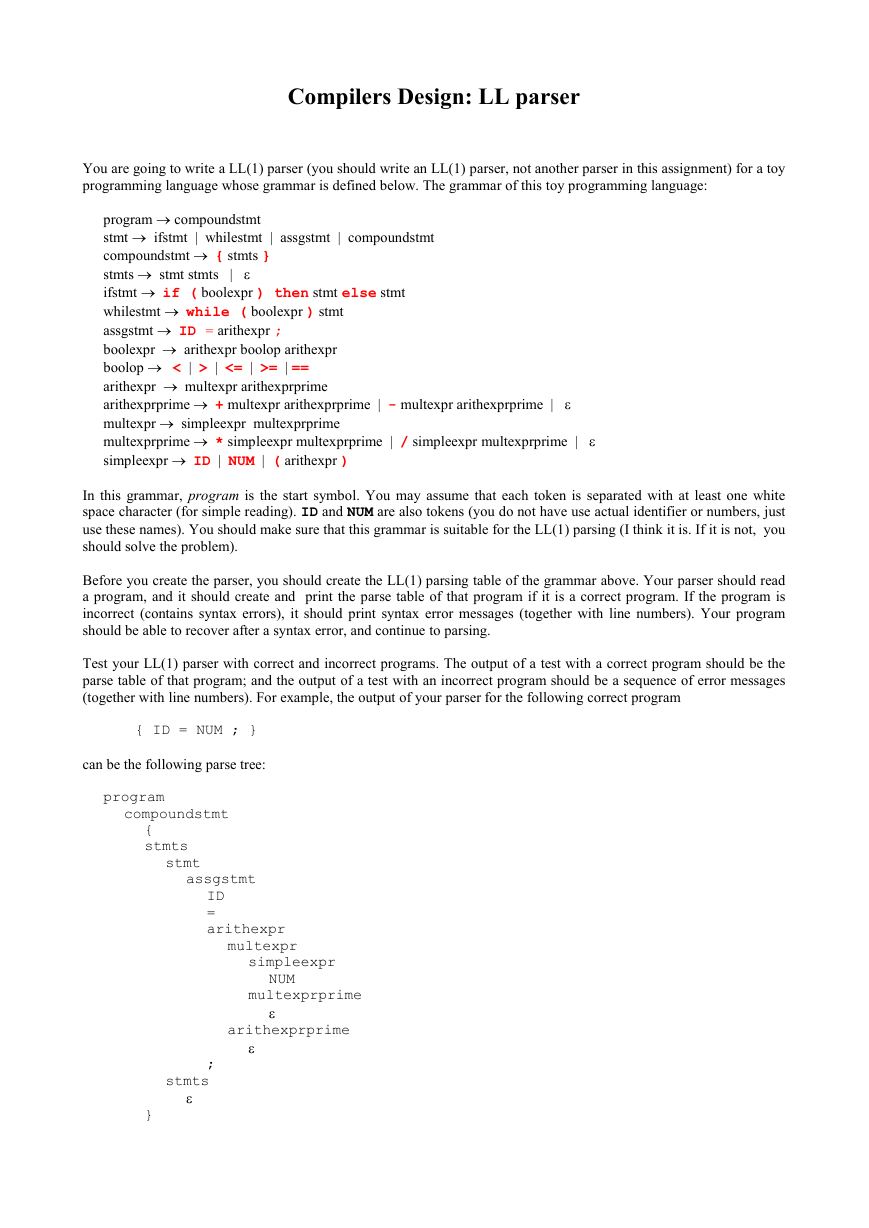Compilers Design: LL parser
You are going to write a LL(1) parser (you should write an LL(1) parser, not another parser in this assignment) for a toy
programming language whose grammar is defined below. The grammar of this toy programming language:
program compoundstmt
stmt ifstmt | whilestmt | assgstmt | compoundstmt
compoundstmt { stmts }
stmts stmt stmts |
ifstmt if ( boolexpr ) then stmt else stmt
whilestmt while ( boolexpr ) stmt
assgstmt ID = arithexpr ;
boolexpr arithexpr boolop arithexpr
boolop < | > | <= | >= | ==
arithexpr multexpr arithexprprime
arithexprprime + multexpr arithexprprime | - multexpr arithexprprime |
multexpr simpleexpr multexprprime
multexprprime * simpleexpr multexprprime | / simpleexpr multexprprime |
simpleexpr ID | NUM | ( arithexpr )
In this grammar, program is the start symbol. You may assume that each token is separated with at least one white
space character (for simple reading). ID and NUM are also tokens (you do not have use actual identifier or numbers, just
use these names). You should make sure that this grammar is suitable for the LL(1) parsing (I think it is. If it is not, you
should solve the problem).
Before you create the parser, you should create the LL(1) parsing table of the grammar above. Your parser should read
a program, and it should create and print the parse table of that program if it is a correct program. If the program is
incorrect (contains syntax errors), it should print syntax error messages (together with line numbers). Your program
should be able to recover after a syntax error, and continue to parsing.
Test your LL(1) parser with correct and incorrect programs. The output of a test with a correct program should be the
parse table of that program; and the output of a test with an incorrect program should be a sequence of error messages
(together with line numbers). For example, the output of your parser for the following correct program
{ ID = NUM ; }
can be the following parse tree:
compoundstmt
program
{
stmts
stmt
assgstmt
ID
=
arithexpr
multexpr
NUM
simpleexpr
multexprprime
arithexprprime
;
stmts
}
�
You should hand-in:
Your source program
The LL(1) parsing table of the grammar
Some test runs of your program with correct and incorrect programs
Above all email to tlf1220@126.com.
DO IT YOURSELF – CHEATING WILL BE PUNISHED
�




 2023年江西萍乡中考道德与法治真题及答案.doc
2023年江西萍乡中考道德与法治真题及答案.doc 2012年重庆南川中考生物真题及答案.doc
2012年重庆南川中考生物真题及答案.doc 2013年江西师范大学地理学综合及文艺理论基础考研真题.doc
2013年江西师范大学地理学综合及文艺理论基础考研真题.doc 2020年四川甘孜小升初语文真题及答案I卷.doc
2020年四川甘孜小升初语文真题及答案I卷.doc 2020年注册岩土工程师专业基础考试真题及答案.doc
2020年注册岩土工程师专业基础考试真题及答案.doc 2023-2024学年福建省厦门市九年级上学期数学月考试题及答案.doc
2023-2024学年福建省厦门市九年级上学期数学月考试题及答案.doc 2021-2022学年辽宁省沈阳市大东区九年级上学期语文期末试题及答案.doc
2021-2022学年辽宁省沈阳市大东区九年级上学期语文期末试题及答案.doc 2022-2023学年北京东城区初三第一学期物理期末试卷及答案.doc
2022-2023学年北京东城区初三第一学期物理期末试卷及答案.doc 2018上半年江西教师资格初中地理学科知识与教学能力真题及答案.doc
2018上半年江西教师资格初中地理学科知识与教学能力真题及答案.doc 2012年河北国家公务员申论考试真题及答案-省级.doc
2012年河北国家公务员申论考试真题及答案-省级.doc 2020-2021学年江苏省扬州市江都区邵樊片九年级上学期数学第一次质量检测试题及答案.doc
2020-2021学年江苏省扬州市江都区邵樊片九年级上学期数学第一次质量检测试题及答案.doc 2022下半年黑龙江教师资格证中学综合素质真题及答案.doc
2022下半年黑龙江教师资格证中学综合素质真题及答案.doc